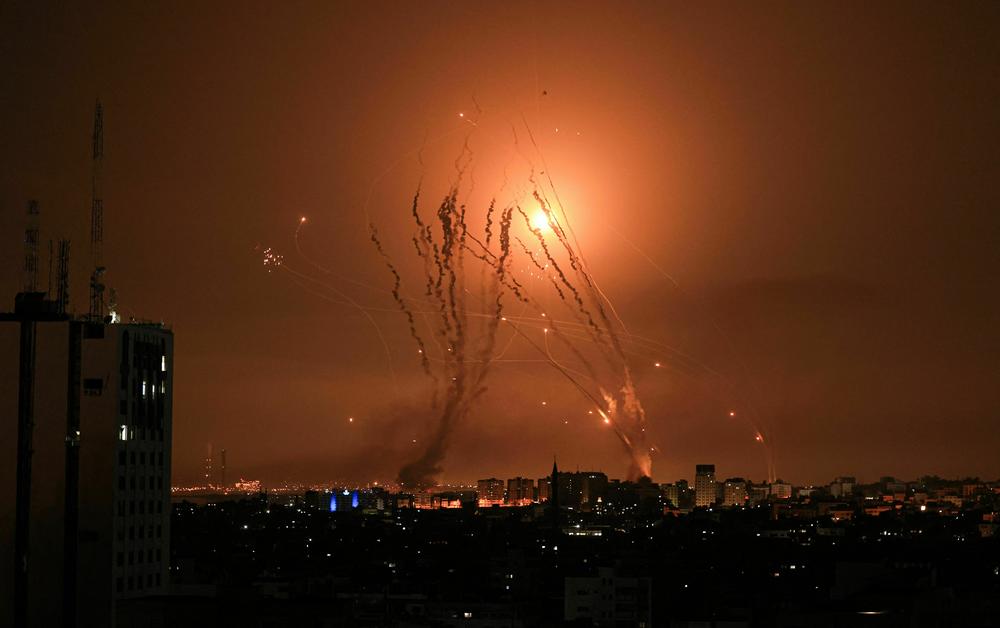Section Branding
Header Content
Here's how Israel's 'Iron Dome' stops rockets — and why Ukraine doesn't have it
Primary Content
Some of the ways in which Hamas initially attacked Israel over the weekend — taking down communication towers with improvised explosives, paragliding over the border and gunning down civilians — subverted one of Israel's strongest defenses: its Iron Dome.
First deployed in 2011, the Iron Dome is a network of radar detectors and missile launchers that work together to intercept incoming rockets.
The highly sophisticated, multibillion-dollar defense system has been under constant redevelopment since its inception in the early 2000s.
Here's how it works, who funds it and why we don't see it in other parts of the world.
How does it work?
The Iron Dome is a mobile air defense system designed to protect against short-range rockets. It was conceived in the early 2000s and became operational in 2011.
Three parts make it work, says Tom Karako, director of the Missile Defense Project at the Center for Strategic and International Studies.
First, there's the radar. When a rocket is launched into Israel, the system detects it and collects data on its flight path.
Second, that information is sent to a computer that calculates where that rocket is going.
"For rockets and artillery, for ballistic missiles, it's pretty predictable. So if you see something traveling on a particular arc, you kind of know where it's going to be going on the rest of its trajectory. You also know where it's going to end up," Karako told NPR.
Third, if the system calculates that the rocket is going to land in a populated area or a place of strategic importance, it activates the last piece of the system — the launcher — which fires Tamir interceptors to collide with the rocket midair.
"If a rocket's going off course and is just going to land in the Negev desert, they're just going to let that one go," Karako explained.
The system is expensive — each missile it launches costs about $40,000 to $50,000 — and the U.S. has poured billions of dollars into its development and maintenance (more on that in a moment).
What has happened since the weekend?
More than 5,000 rockets have been launched into Israel since the attacks from Hamas began Saturday, according to the Israeli military, which says the Iron Dome successfully neutralized most of them.
In the past, the Israel Defense Forces has said the Iron Dome's success rate is about 90% to 97% in its capacity to seek out and protect civilians from incoming weapons.
And as Karako explains, the aim of the Iron Dome isn't necessarily perfection.
"The Iron Dome, in particular, is kind of the poster child for the 'good enough' high success rate," he said.
"Their approach to acquisition has been not the most exquisite and most expensive interceptor, for the perfect interceptor rate — but rather, large quantities of interceptors that are lower cost and good enough to get after the threats."
Where did the Iron Dome come from?
Development for the Iron Dome began in Israel in 2006, in response to the conflict between Israel and Hezbollah in southern Lebanon.
The project was spearheaded by RAFAEL Advanced Defense Systems, a state-run defense firm that would spend the next five years fine-tuning the technology. The U.S. has invested nearly $3 billion into its launchers, interceptors and general maintenance, according to a Congressional Research Service report.
And there is likely more U.S. aid in the pipeline, with President Biden saying on Tuesday that the federal government is "surging additional military assistance, including ammunition and interceptors to replenish Iron Dome."
In addition to Biden's pledge, a group of U.S. lawmakers in the House introduced a bipartisan bill this week that would appropriate an additional $2 billion to help bolster the Iron Dome.
Rep. Josh Gottheimer, D-N.J., said the move would be "critical to increasing American security assistance for Israel's missile defense system, which is saving millions of innocent lives."
Is it used elsewhere, like Ukraine?
Thanks in part to the investment and collaboration with Israel on the Iron Dome, the U.S. has two Iron Dome batteries.
The Ukrainian government has made a number of requests for Israeli-made defense systems — including the Iron Dome — since Russia invaded in February 2022.
Ukrainian President Volodymyr Zelenskyy addressed the Israeli Knesset in March 2022, stating: "Everyone in Israel knows that your missile defense is the best ... and you can definitely help us protect our lives, the lives of Ukrainians, the lives of Ukrainian Jews."
Yet in June of this year, Israeli Prime Minister Benjamin Netanyahu said in an interview with The Wall Street Journal that Israel would not be sharing technology or insight on its missile defense system with Ukraine, citing concerns that "if that system were to fall in the hands of Iran, then millions of Israelis would be left defenseless and imperiled."
But Karako says Israel's exclusive use of this technology could change.
"There are other countries in Europe and elsewhere in the world that are certainly looking at this ... for its relatively lower cost, for its sooner availability and for its proven record."
Copyright 2023 NPR. To see more, visit https://www.npr.org.




